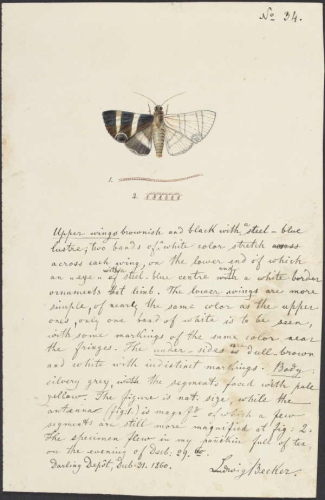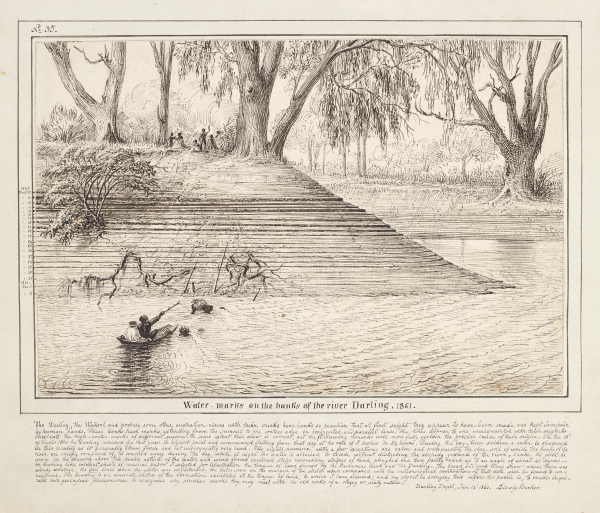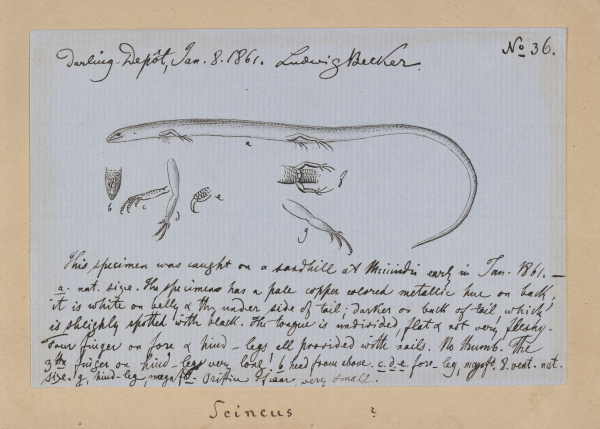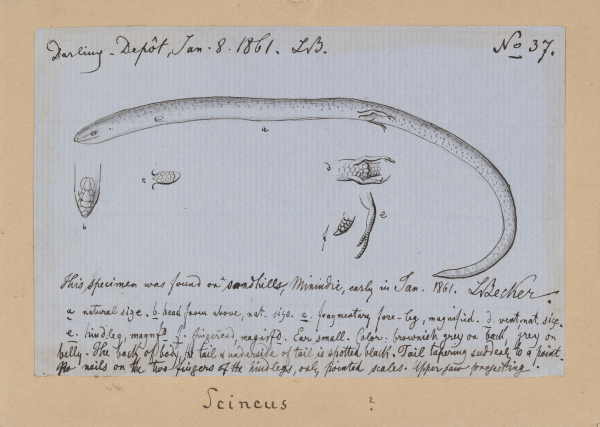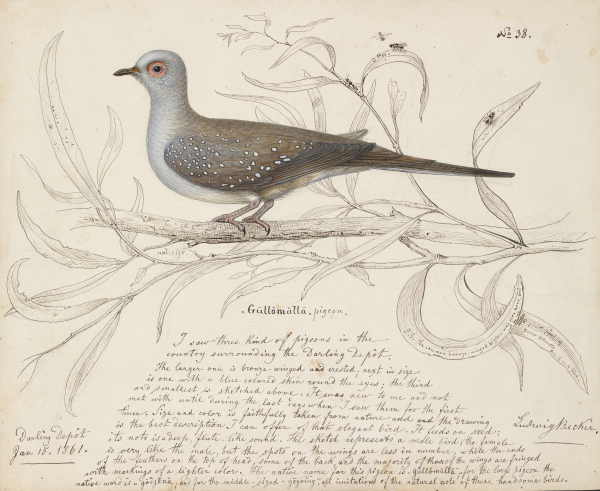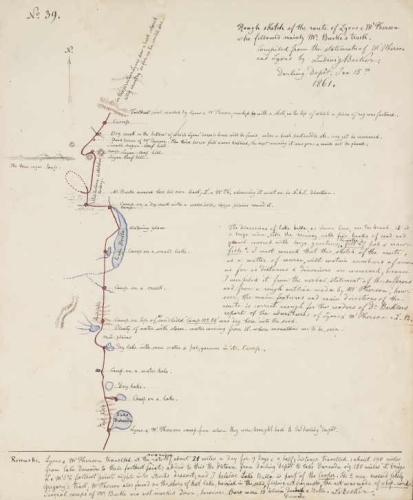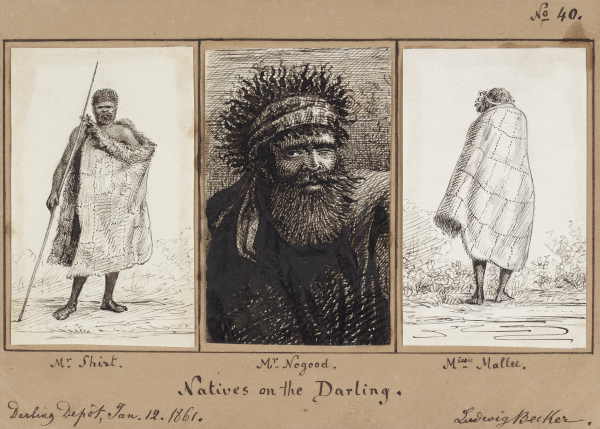|
Monday, 1 October 1860.
Last night was very cold with hoarfrost in the morning. Having had no sleep for the last two nights but plenty of hard work during day-time I felt somewhat unwell, however, I began to work as usual at 5 o' clock in the morning. We commenced saddling and loading the camels and were ready to start by eleven o'Cl. As I have said already 400 lb was nearly each camels share, mostly consisting of bags of flower and sugar; each of these bags weighed 200 lb, and as each camel had to carry two of them which being fastened together before they were put on the pack-saddle, it is easily understood that 4 men were required to lift this weight into the air and then let it carefully down on the camels back; this had to be done a dozen-times. It is a most exhausting kind of labor and the new canvass bags soon told upon our fingernails –half of mine were split and bent. Before we marched Mr Burke told us that, from today, we had to walk, inch for inch, all the way up to the Gulf of Carpentaria, as all the camels and the horses were required to carry stores etc. To Dr Beckler and to me he said: 'now Gentlemen from this time you have to give up your scientific investigations but to work like the rest of the men, as long as you are on the road or not free from camp-duties; at the same time you have to limit your materials and other things required for your investigating, to the utmost, in numbers as well as in weight and size of the parcel.' I made up a small one which was put on a pack-horse together with the Doctors parcel containing 30 lb of medicine; bottles and packages included in the weight. At eleven o'CI a.m. Mr Burke left the camp with some pack-horses taking with him the 7 waggons, he went in a more westerly direction then we to avoid the steep sandhills which we with the camels had to cross. At the same time Mr Landells started. Non of us was told how far or how long we had this day, or rather the rest of this day, to travel, and as nothing but tea and biscuit with a little cold mutton was served out early in the morning, and we had no food before starting, I thought, in a few hours we would halt on some waterhole to take there the required nourishment-but nothing of that kind was allowed: we marched on without rest and food for twenty four (24) miles over high hills covered with a deep, loose sand, and arrived at night at a plain containing some water. I had no food for nearly three days; partly in consequence of my indisposition, and no sleep for two nights, and had to pull, in the heat of the day, three camels for 24 miles through a most wretched country -it was quite natural I should feel weak. It was about sunset when I asked Mr Landells to stop only 5 minutes so as to be able to recover myself as I felt fainting. Mr Landells answered: 'I can not stop; loaded camels won't rise again when once allowed to lie down; give me your camels, take rest if you require it, and follow at leisure'. Fortunately for me that, when leaving the camp, I had picked up a thrown-away empty gunpowder flask, large enough to hold 4 ounces of water, which I had found at noon in a small clay-pan, and these few drops now enabled me to reach Mr Landells camp Just in time to hear the order 'now then, Mr Becker, look sharp, unload your camels!' and so I did, of course. It was late at night, when, after taking some tea and cold mutton we stretched our over-tired limbs under green bushes and notwithstanding the drizzling rain which had set in, men and beasts soon were favored with a sound Sleep, the best reward for what they, this day, had done.
Tuesday, 2 October 1860.
That ruinous work, loading the camels, commenced before day-break and we were ready by 9¼ o'Cl to leave the damp ground going towards McPhersons station on the Darling, distant 24 miles. Being now one day wiser I put a piece of bread into my pocket, filled the powder-flask with fresh rain-water, and with the rope over my shoulder I led or pulled my 3 camels through the most dismal country we had passed yet. Sandhills over hundred feet high, with a heated soil, consisting of loose sand in which ‘porcupine grass' abounds lay before us -one behind the other, like gigantic sand ripples. They stretched as far as I could see in a S.N. direction, about parallel with the Darling and become less high in nearing that river, and disappearing when the alluvial deposits of the Darling meets them. These mud-plains we reached when about one mile distant from McPherson's station, a beautifully situated place on the banks of the Darling. From this spot, five miles higher up the river, and left in charge of Mr Wills, was our camp which we reached at 5 p.m. The last 48 miles we had travelled fatigued every one of us to a great extent and we welcomed heartily the fine green spot on a Darlings-bend, where we were told to pitch our tents and to stay for a few days. That place is called Bilbaka, and here I had time to begin and to finish several sketches of which I now will give the explanation. But before doing so I first shall make a statement which I consider to he a duty to myself as an artist and an observer, as it will account for the short comings which will be found in the late productions of my pen and pencil. The 'instructions' I received contain an article running thus: 'Diary to be kept regularly and all observations made during the day to be entered before the next day, and as soon as possible after the camp is pitched for the night, and the necessary duties connected with camping, attention to the stock etc. are completed-This at all times and in all cases to he determined by the Leader'. Now, a direct order was given by Mr Burke, that I had to give up all scientific observations until further orders. -To obey these different commands I was obliged to use the night. When all in the camp were asleep or at rest, I sat then up writing or sketching till midnight; This sort of work robbed me night after night three hours sleep and many times I slept in 24 hours only four. If you further consider that in consequence of the hard and rough work I had to perform during day-time my finger and finger-nails were in a pitiable condition, it is easily understood that under these circumstances pursuing science is rather a heavy task. However, I did what I could and not less. I sketched at Bilbaka Gecko No 1 my observations and description of which are attached to that sketch No. 12. No 13 shows the banks of the river close to our camp. A peculiarity noticed already at the river Wakool, is here again visible, viz. the regularity of the banks of the Darling as if the stream was running through an artificial canal. The waters of that river sometimes rise to such a height as to overflow by four feet the banks. The marks of such floods are about 25 feet above the level of the Darling at the time this little sketch was made. The old, big tree on the left had its roots washed out by those high floods and presents now a picturesque view: the tree seems standing on its own roots which look like crooked columns, forming grotesque arches, on the top of which the hollow stem of that old Eucalyptus towers. No 14 Is a sketch and description of a fish caught in one of the back- waters of the Darling. No 15 represents the scene round the tent which gave shelter to Dr Beckler and myself The 3 trees near it differed in form and color so much and the whole scene appeared to me so pleasing that I could not help painting it. The small tree to the left with its fresh looking green foliage is a species of Acacia; next to it, of a more sombre hue, stands a larger tree with a very fine flower visible here and there between the small leaves; this tree is a species of Tecoma; in the back of the scene Is that old eucalyptus again, sketched in No 13. When sitting up in that tent in the dead of night and all and every thing around me was silent, a bird selected every night the same branch of the sombre tree with the sweet flower, right over our tent, whistling from 9 o'CI in the evening till daylight; it never flew away, or felt disturbed by the light and life a few feet beneath it. It Is a fly-catcher and although hundreds of them are all day long visible, only one of them sang at Bilbaka at night. No. 16 shows a beetle the description of which is found underneath the drawing. The Darling Pea (No 17) is a very fine looking flower; it is confined to the banks of the river and I have not seen it further inland then 50 yards from the water. It is said the 'Darling pea' when eaten by horses maddens them. What I could learn about this peculiar effect of the plant it is this:- No horse suffers as long as it feeds on that plant and on green grass at the same time; but the pea shows its bad effect in the heat of the summer when all other herbs and grasses are gone and the horse is then obliged to eat that evergreen plant. It appears to me that indigestion and costivness is the principal cause of the disease, and I believe that when the first symptoms of the malady show themselves, a strong purgative and green food will be found more effective then bleeding, usually adopted; this weakens a horse without curing it. The sketch represents the common red Darling pea of which I found a variety (?); the flower of this is of a pure white, slightly tinted on the mouth of the flower with a delicate, pale flesh-color. I found it at the Darling Depot, near the Bamamero Creek and handed it over to Dr Beckler for transmission to you and respective the Govt. Botanist.
Wednesday, 3 October 1860.
To day Mr Burke arrived in the camp with the horses; the waggons were left behind.
Thursday, 4 October 1860.
Hoarfrost in the morning. Mr Burke and the Doctor left the camp to meat the waggons. River Darling is rising, its waters are of a coffee-and plenty of milk- color; velocity of current 3 feet in 4 seconds. A large and uninterrupted mass of small water plants is carried down the river: it looks as if young ice of an olive color was moving before your eyes.
Friday, 5 October 1860.
Mr Burke today, after having spoken to him, allowed us to add to our personal stores the weight of 10 lbs; at the same time he said: ‘and now, if any one, whoever he may be takes one ounce more then 40 lb weight of private luggage with him, I shall leave this luggage behind and the man too -now you know it.' -The camels who had to bring up to camp the stores from the waggons were not to be found. Beludge arrived on a camels back and said: 'Camels gone, all the Datchi (she-camels) gone, Datchi plenty no good!' He was looking for them but found only a camels blanket. King's, McDonough's and Hodginsons turn to watch the camels in the bush, non of these men had returned at sunset. Mr Landells and Beludge mounted at once a camel to look for the beasts and their custodians. When darkness came on I proposed to Mr Burke that he and I should go in the bush and take with us the Gong and firearms to make signals with them for the three men, and so we did-but found only King who could not tell us where the two others were. After tea the men in camp went out again in a easterly direction and made a large fire on a hill, which brought McDonough home. At the same time the Indian, Dost Mahomet, arrived driving some of the runaway camels into the camp. All the men returned to Bilbaka, with the exception of Hodginson, who was not to be found.
Saturday, 6 October 1860.
Mr Burke went with the camels to M'Pherson's station to fetch up stores. I, with three other men, divided the flower into bags each holding 50 lb weight, this took us 7 hours to do it. At the same time I placed into each of these bags, for security sake, several flasks, containing gunpowder. At noon Hodginson arrived in camp; he has lost last night the direction and himself, while trying to discover the track of the strayed-away camels.
Sunday, 7 October 1860.
Mr Burke intended to leave Bilbaka today but we were retained on account of the want of camels. Early in the day I heard Mr Burke talking, in front of his tent, very loud to Mr Landells; the nature or the object of that communication seemed to me to be a disagreeable one to both of them: I left my tent and went away some distance as I do not like to be near where hard words are used about private affairs. Mr Landells later in the day voluntary told me that he would resign and return to Melbourne, he did not tell me the reason why? - and I did not ask him why -There were still 8 camels missing and Mr Landells again were soon in search of them, but returned unsuccessfully at night -During the day the horses with some men and part of store left the camp; they moved on about four miles higher up the river.
Monday, 8 October 1860.
The cook, who was send yesterday on horse-back, to M'Pherson's returned today without hat and horse, saying he lost both last night during the rain and he did not know how. Mr Brahe was ordered to find the horse. Mr Burke returned from M'Pherson's station, telling us that a steamer was approaching which would take stores up to Minindie. Mr Landells again went out for the lost animals and mounted for that purpose a camel taking behind him a 'black-fellow', I think this was the first time that an Australian aboriginal rode on a camel. They went in a southerly direction. Soon after them, King and Beludge, both also on one camel, left the camp riding more north-eastwards. These two men did not return at night.
Tuesday, 9 October 1860.
Steamer Mulgawaakee arrived. It was intended to call the horses back for putting their load on board the steamer, but they could not be found. Goods and stores brought on board the vessel; she left again for Minindie at 8 a.m. Soon after this the horses with their loads arrived at Bilbaka but too late, although the steamers puffing and paddling was still audible.-Several of our men and some black fellows went now in search of camels and to look for King and Beludge.
Wednesday, 10 October 1860.
In the morning non of the men had returned; the following were out searching: King and Beludge, Brahe and native, Charley and black fellow, and today Mr Landells started also with Dost Mahomed; they ally however returned in the course of the day, and King and Beludge at 7 o'Cl in the evening with the lost camels. They were found about 20 miles north-eastwards from our camp quietly grazing. The country in that direction according to Kings statement, consists of the same sort of sandhills already described, but they were higher; between them numerous pools of water were seen but no running creek. Today I had to watch the camels while they were out feeding. The news of Stuarts' return from the Interior reached the camp at sunset.
Thursday, 11 October 1860.
Once more the camels were loaded and we started at 2 p.m. Mr Burke in advance with the horses. I had again 3 camels under charge, amongst them one of the 'Cremorne beasts' a very obstinate one, which, when tied behind the others, commenced biting them, and when in front, it walked so slow that Mr Landells were obliged to use his whip. Notwithstanding this my hands and shoulders were sore by pulling the rope, so as to keep pace with the other animals now some distance ahead. Suddenly one of the large Indian camels, seeing his companions in the distance, attempted to advance, but as my three camels were tied together, he was unsuccessful, but commenced kicking and Jumping and at last his whole burden of about 500 lb weight lay on the ground and saddle- girth and nose-string broken; at the same time that hump-backs maneuvering dislodged part of the next camels load. With the utmost difficulty Mr Landells and myself had to re-load the animals and to mend the girths and leading-strings, and this when darkness already had set in, and the impatience of the camels-to follow the others-had to be counteracted with danger and difficulty. It was a most harassing affair; besides this neither Mr Landells nor myself were sufficiently prepared to go on in this way, we had no food and no water, and the moon was down -but a few matches assisted us in looking for the track. On we went for miles and miles; Mr Landells, staggering in front, was scarcely able to keep himself free from failing asleep; I, behind, pulling the camels and looking out anxiously for our camp-fire-when suddenly the whole firmament and the country underneath it was lit up by a day-like light: a splendid meteor fell in the west. I was fortunate enough to get a full sight of it from its beginning to the end. The sketch of it, No 26, as well as the description of the phenomenon is already in your hands. I only have to add that this meteor was the largest I ever saw; I never before observed one which from apparently a most minute point increased to such a size during so short a time and within so small a space on the firmament. -For half an hour that colossal shooting star gave us some matter for conversation, but soon the previous dullness prevailed again. Hallo! There is the camp-fire, how lovely it flickers through the twigs of the underwood; at last we are near it -we whistled, called and coohooid -and received an answer from a lonely shepherd on the other side of the Darling. But there is another shine ahead of us, this must be the camp-fire of Mr Burke- alas! only a setting star. One disappointment followed the other till half an hour before midnight when we reached the long longed for halting-place. We found everyone asleep, however, the cook willingly assisted us in getting a drop of tea. It was near two o' Clock before our overtaxed limbs were allowed to rest. We had travelled this day 22 miles.
Friday, 12 October 1860.
At daybreak the Gong awoke us and at 7½ I left the camp on horseback in company with Mr Burke and the packhorses, a great relieve to me, as I had walked for so long a time and so long a distance with obstinate camels. We reached after 15 miles ride 'Cuthro', this is a fine camping place where we and the horses had a short spell; marching from there 10 miles further on we camped for the night at a 'Darling bend'. The country we had passed through today was of the prevailing Darling formation: sandhills and dry mud-plains. We came over some undulated country with a sandhill to our right, about 80 feet high and Mr Burke kindly gave the permission to ride on the top of it to see what lay before us: I found the panorama from that hill ocean-like, only in N.E. some elevations reached over the dead level of the country and broke the line of the dark colored horizon. The hill was undermined by numberless holes, some very large, probably made by Wombats, the others belong to Wallaby's. The surface of the summit of the hill is strewn with large masses of limestone concretions, looking like so many fossil bones. -We soon arrived at a spot where the road went round a remarkable place called 'the Mallee Sand Cliffs'. The sandhills approach here the Darling so much, that its high-water in certain seasons, reached the foot of those halls washing away the loose material. Deprived of their foundation the overlying masses come down and are also carried away by these periodical floods, leaving behind, after their subsidence, a level sandy plain bordered by cliffs from 20 to 60 feet hight. For years no fresh flood disturbs the product of the last one; but now the action of the atmosphere takes place. The rain-water coming from the plateau above, rushes, down those sand-walls, producing cracks, fissures, crevices etc; small bills, cones, spures of hillocks and miniature promontories; exposing to the eye the different layers of sand separated by thin strata of calcareous matter, until a picture is created such as I attempted to copy. -It will be seen that the foot of the 'cliffs' is composed of a brownish-red sand, which color changes, higher up, gradually to yellow, when it becomes nearly white at the top of the cliff These different layers of sand all horizontal are very distinct: the separating sheets of calcareous matter are less affected by the rain water, they being harder, it renders the eye to count and measure correctly those deposits of sand of which we at present do not know to what geological period they belong, as, so far as I know, no fossils were found in that formation. The first impression of the scene upon me was a very striking one-I did not know what to make of it. It looked to me as if it were a sort of a model for an alpine formation the pines on the bottom of the cliffs still more reminding one on some scenery in Switzerland; -then again it was to me as if l were in the Gallery of an enormously large play-house and looking down upon the stage and at the painted back-ground illustrating some scene out of 'William Tell' or of 'Linda di Chamounl'. As it is, however, these sandcliffs are entirely the result of natural forces, and human hands had no play in it: no sand pits, no excavations are to he seen.
Saturday, 13 October 1860.
Started at 7½ and arrived a 5 o' CI at our halting place from where I sketched No 22, entitled 'a Darling bend'. I made several of such smaller drawings only for the purpose of giving an idea of the country we went through and also to show the character of the trees, of which nearly every one in my sketches is a portrait. On the way I saw, at noon basking in the sun, a fine specimen of a guano which kind I do not remember having seen it before. It was of a slender form, about 2 feet long of a yellow color with black markings from head to half of tail, the other half was free from this markings-legs black with large, rounded, yellow spots. I was sorry not to be able to pick it up and to carry it with me.
Sunday, 14 October 1860.
Left camp at 6½ when I met with painful accident, my horse trot upon my foot, splitting the nail of the big toe, and forced one half of it through the flesh down to the bone. In great agony I rod on and we arrived at 9½ a.m. at McClouds station. Here the steamer Mulgawaukee lay at anchor, it being Sunday. At this place we saw for the first time Mr Wright who showed us a near spot, opposite Kinchika, where we crossed the Darling. The horses, after some delay and trouble swam over and were safely landed. We passed this morning over a country strewn with trees blown down in a south-easterly direction: it was the effect of a N.W. hurricane which blew for an hour in Sept. 1859.
Monday, 15 October 1860.
Mr Burke with the horses arrived at Minindie at 11 a.m. and shortly afterwards the steamer and Mr Landells. Unloading steamer.
Tuesday, 16 October 1860.
Camels crossing the Darling at Kinchika. Mr Burke told us that Mr Wright was to accompany the party up the country. At the same time Mr Wills informed me that Mr Landells and Dr Beckler had send their resignation to Mr Burke.
Wednesday, 17 October 1860.
Today the camels arrived at Minindie. Dr Beckler was ordered to take charge of the depot until the arrival of another Doctor. Mr Burke said to me 'do you like to stay in the depot, or to go on with me now to Cooper's Creek? If you like to be with the party, you are welcome, but I must tell you, there is no time for scientific researches, nor a horse or camel to ride on, you will have to tramp all the way, and must do the work like the other men.' I answered, ‘Sir, I am not afraid to work, although you will find men possessed of greater physical power than I can boast of -but to walk all the way- you see, Mr Burke, is impossible. in consequence of the accident I met with, I am lame at present and can hardly stand. So I think it is better for you and me when I remain here for some time in the depot, where I shall find time to work up the matter and material I gathered in reference to natural sciences.' Mr Burke then said ‘very well, now listen, I intend to look for a road up to Cooper's Creek, and how the way is, and about the water; and as soon as I have found a spot where to form a depot, I shall send for you to come up with the others and with such things as wanted.'
Thursday, 18 October 1860.
Preparations for the departure of Mr Burke.
Friday, 19 October 1860.
Mr Burke left Minindie for Cooper's Creek. The particulars of his departure I already have communicated to you.
Saturday, 20 October 1860.
Dr Beckler and Hodgkinson went up the Darling to look for a good camping ground, returning at night.
Sunday, 21 October 1860.
Watching our things, which lay unprotected on the rivers bank. Finish some sketches.
Monday, 22 October 1860.
We left Minindie with part of store and arrived at the junction of the Bamamero Creek with the Darling, after 8 miles travelling. In the afternoon the men and camels went back to Minindie. I remained behind and after storing safely the goods brought up, I put myself under shelter by pitching my tent on a spot high and dry and near a cluster of beautiful Gum-trees. |
|



